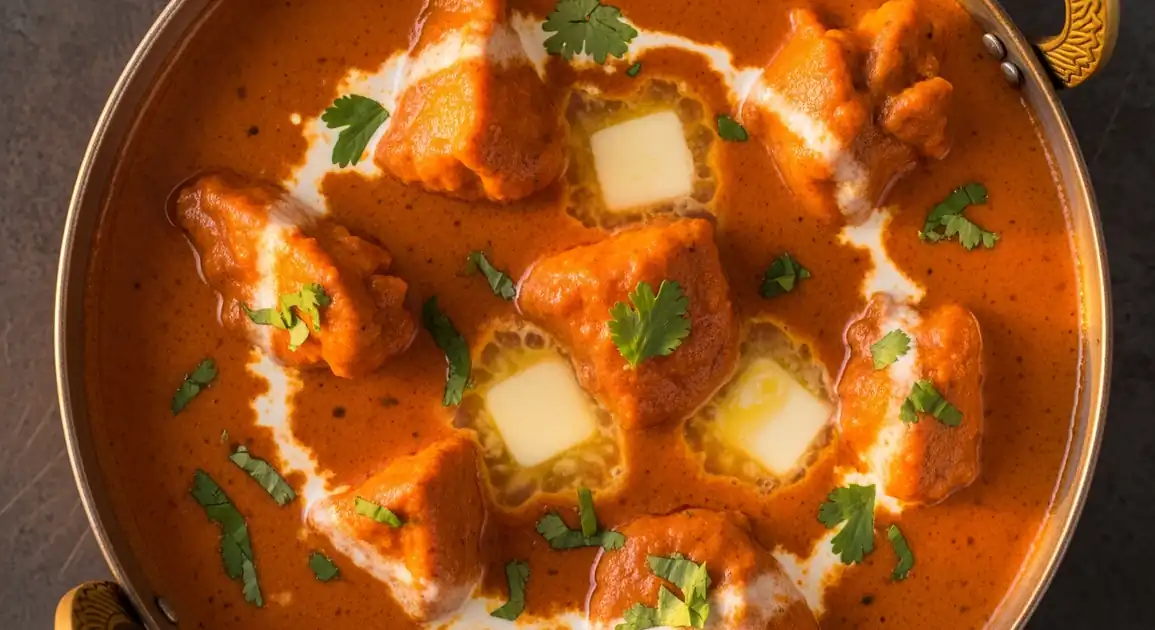Butter Chicken
मुर्ग़ मक्खनी (Murgh Makhani)

Description
While Butter Chicken originated in Delhi, it has become a staple across India, especially in the North. Each region adds subtle variations while maintaining the dish's essential character. You'll find it in virtually every North Indian restaurant throughout the country, though the Delhi version remains the benchmark for authenticity.
Dietary Information
Serving information
Serving style
Traditionally served in a small metal or clay vessel (handi), accompanied by naan bread or rice. Meant for sharing as part of a larger meal.
Quick facts
Available during standard restaurant hours, typically 12 PM - 3 PM for lunch and 7 PM - 11 PM for dinner.
Safety Tips
What to Look For
-
Freshly prepared gravy with a vibrant orange-red color
Quality butter chicken should have a fresh, vibrant appearance. Dull or brownish color might indicate reheated or old gravy.
-
Properly cooked chicken with no pink centers
The chicken should be fully cooked but still tender. Cut into a piece to check if uncertain.
-
Clean, well-maintained tandoor if visible in open kitchens
A properly maintained tandoor indicates attention to detail and traditional cooking methods.
-
Restaurants with high turnover and local patronage
Popular establishments typically serve fresher food and maintain better quality control.
What to avoid
-
Extremely bright red or unnaturally colored gravy
Excessive food coloring might be masking poor quality ingredients or old sauce.
-
Excessively oily surface with no visible cream incorporation
Some oil separation is normal, but too much indicates poor preparation or old, reheated sauce.
-
Pre-cooked chicken simply dropped in sauce
Authentic butter chicken uses tandoor-cooked chicken that's then finished in the gravy, not boiled chicken pieces.
-
Gravy that's been repeatedly reheated
This dish should ideally be prepared fresh. Watch for gravy with a skin or uneven consistency, signs of repeated reheating.
Price information
Price range
Budget tips
- Mid-range restaurants typically charge 250-500 INR for a portion.
- Luxury hotels and fine dining establishments may charge 600-900 INR or more.
- Lunch thali specials often include butter chicken at better value than ordering separately.
- Portions are typically meant for sharing; one order usually serves 2-3 people when eaten with bread or rice.
Value indicators
- Fresh, house-made tomato gravy rather than pre-prepared sauce.
- Visible tandoor char on the chicken pieces.
- Proper thickness of gravy - neither too watery nor too thick.
- Balanced flavor profile with no single element (sweet/spicy/tangy) dominating.
- Served hot in traditional serveware like copper or clay vessels.
Where to Find This Dish
North Indian Restaurant Districts
Found in virtually any restaurant serving North Indian or Punjabi cuisine.
Specialized Punjabi restaurants, Dhaba-style eateries, Hotel restaurants
Dinner (7 PM - 10 PM), Weekend lunch
Business Districts
Popular lunch option in restaurants near office complexes.
Business hubs, Commercial centers
Lunch (12 PM - 2 PM)
Vendor Tips
- Ask if the chicken is cooked in a tandoor first, which is essential for authentic flavor.
- Look for places where butter chicken is specifically highlighted on the menu as a specialty.
- Smaller portions often indicate freshly prepared batches rather than bulk cooking.
How to Order
Regional Variations
-
Classic Delhi Style
(दिल्ली स्टाइल बटर चिकन)
The original version featuring a balanced, moderately sweet gravy with prominent but not overwhelming tomato flavor and visible cream swirls.
-
Restaurant Style
(रेस्टोरेंट स्टाइल बटर चिकन)
Often richer and more indulgent than the original, with higher butter and cream content, smoother consistency, and sometimes slightly sweetened.
-
Home Style
(घर का बटर चिकन)
Typically less rich than restaurant versions, often using less cream and butter, sometimes with a chunkier tomato base.
-
Smoky Style
(स्मोकी बटर चिकन)
Emphasizes the tandoor's smoky flavor, sometimes enhanced with additional smoking techniques like placing a hot coal in the finished dish.
-
Punjabi Style
(पंजाबी बटर चिकन)
Often spicier than Delhi versions, with more pronounced ginger-garlic flavor and sometimes additional Punjabi spices.
Cultural context
History
Butter Chicken was reportedly created in the 1950s at Moti Mahal restaurant in Delhi by chef Kundan Lal Gujral. The innovation came from a need to use leftover tandoori chicken, which was mixed with a tomato-butter-cream sauce to prevent it from drying out. This accidental creation became one of India's most famous culinary exports, evolving from a restaurant specialty to a globally recognized symbol of Indian cuisine while maintaining its ties to Delhi's culinary heritage.
Local significance
A source of culinary pride, particularly in Delhi, representing the innovation of Punjabi cuisine post-partition. Considered one of India's most successful culinary exports.
Eating customs
- Eaten with tandoori roti, naan, or rice.
- Traditionally scooped up with pieces of bread rather than using cutlery.
- The gravy is valued as much as the chicken pieces themselves.